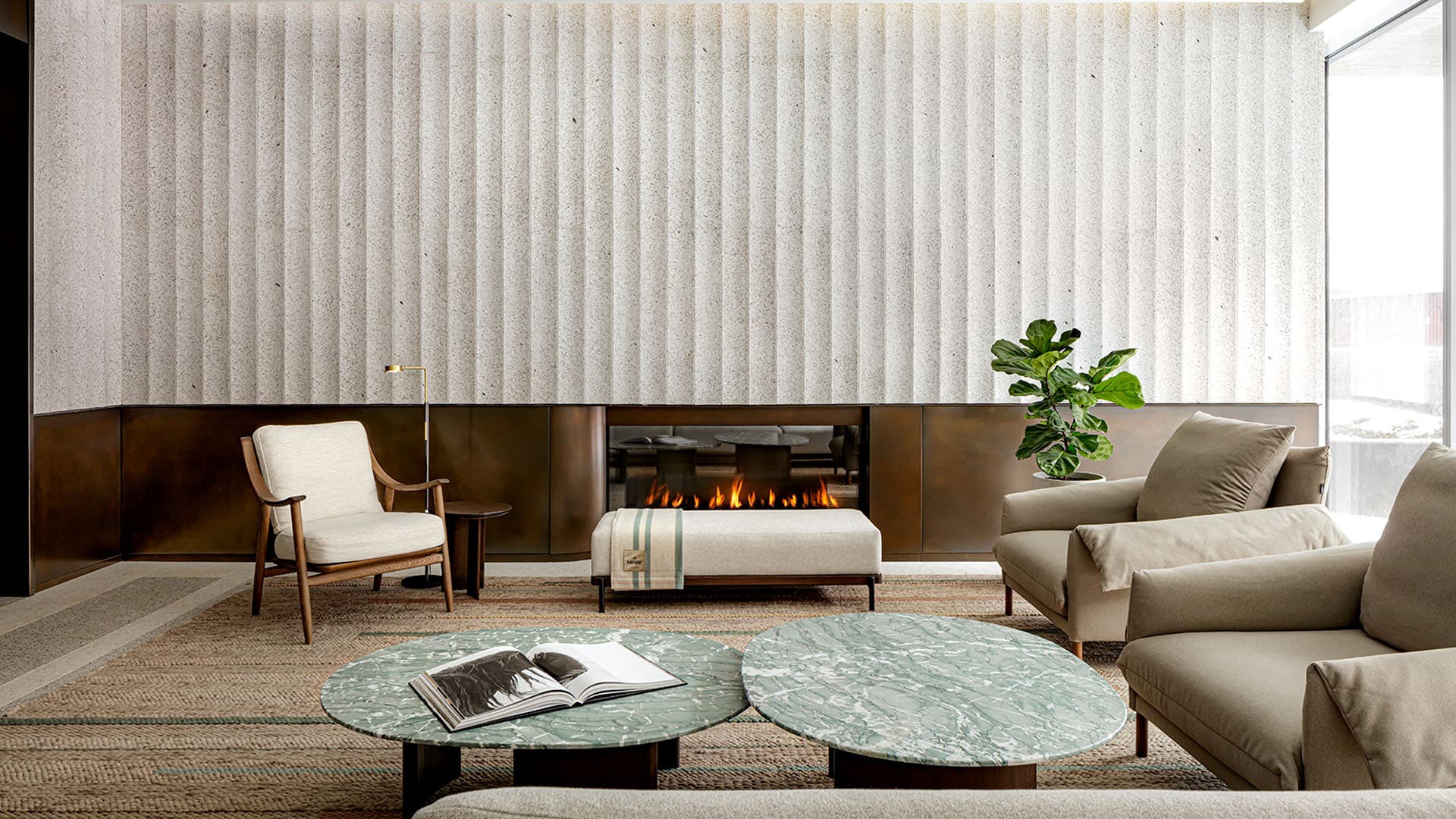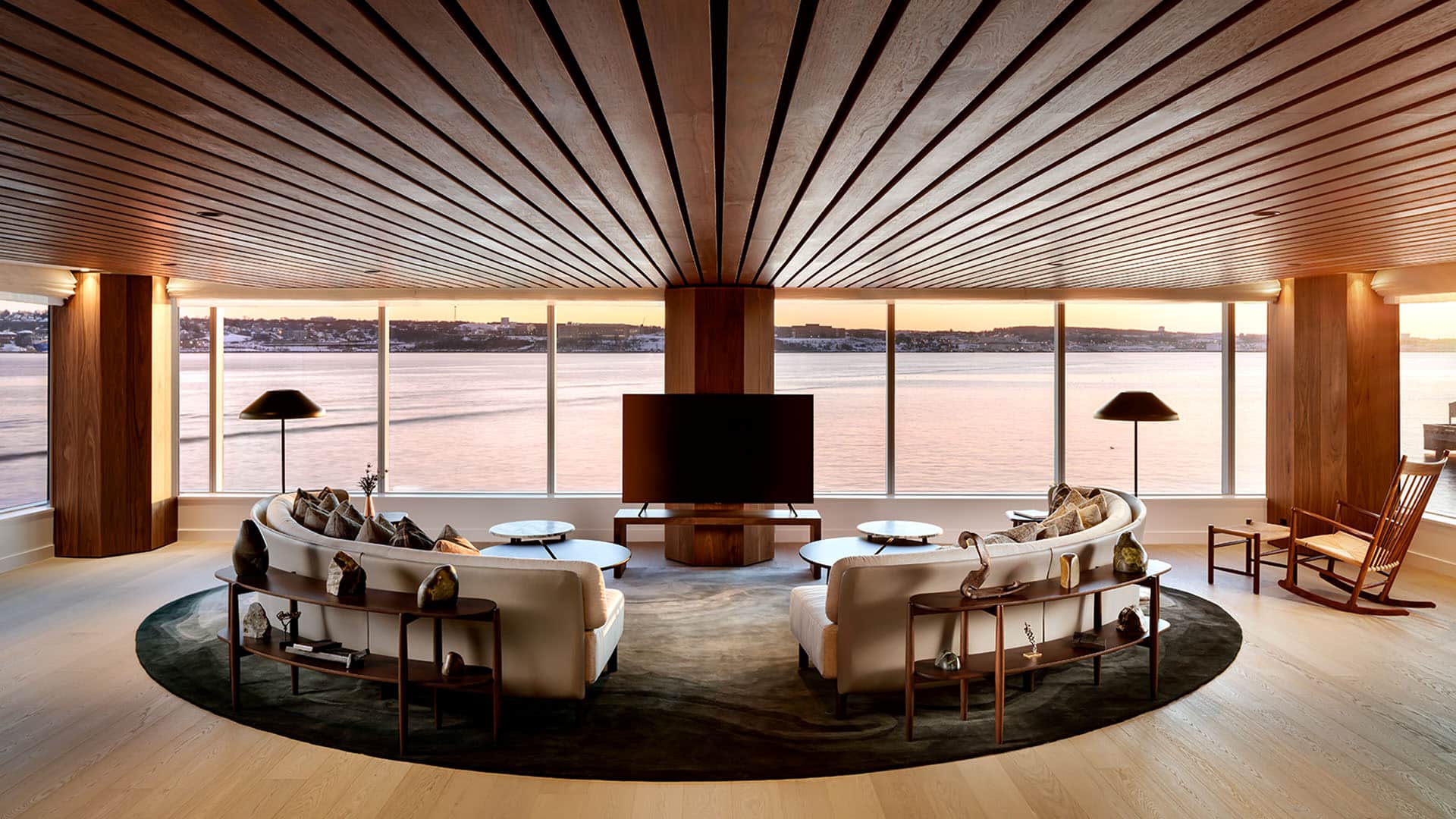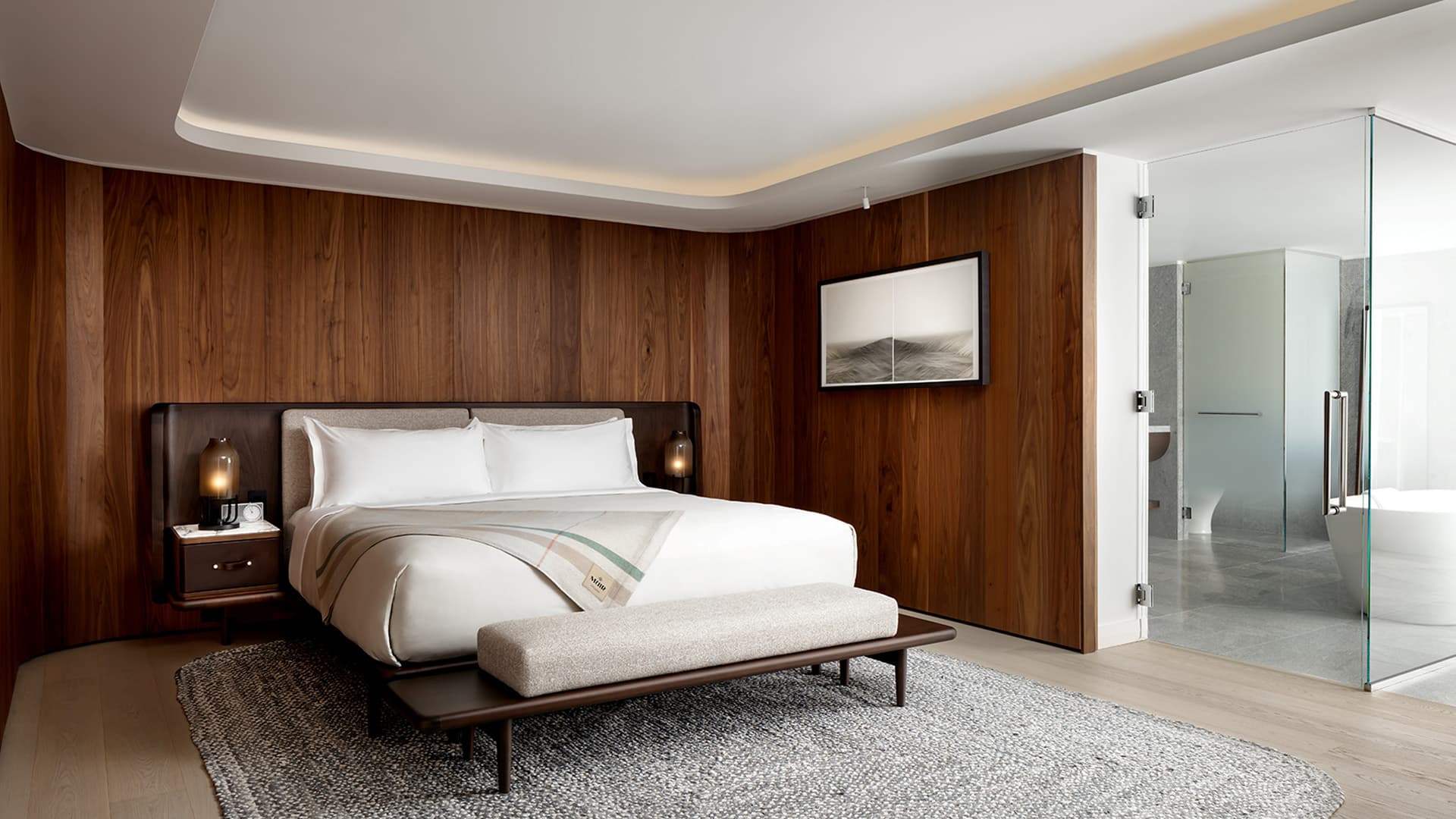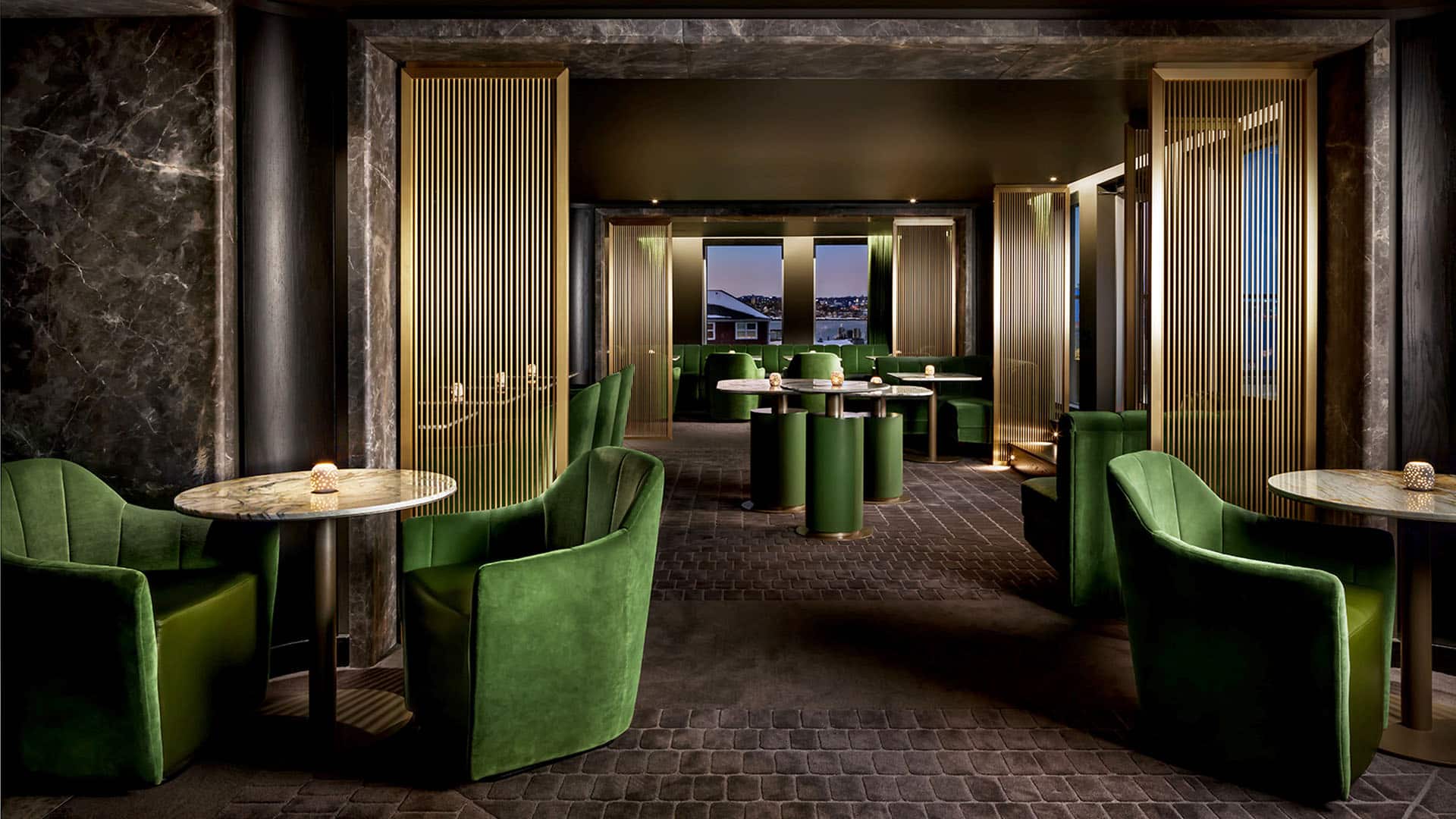
Cozy next to the fire. (Photo: Marriott International)
Travel by DesignCrafting a Hotel Born of Local Maritime Culture at Muir Halifax, Autograph Collection
By Taylor WoodyAs the capital of Nova Scotia, Halifax is known for its charm, its culinary scene and its coastal climate. Built on one of the largest natural harbors in the world, this Canadian city is often filled with a gentle fog and sea mist — creating a sense of place that’s simultaneously rooted in the ocean and the earth.
Muir Halifax, Autograph Collection has been painstakingly designed to honor and integrate the local maritime history of Halifax. The hotel is nestled seamlessly into the Queen’s Marque waterfront district, where locals and visitors alike gather on the public boardwalk that envelops the hotel and meets the waters of the harbor.
The architecture of Muir is full of texture and natural materials inspired by the local topography; sandstone, granite and Muntz metal play a prominent role in the hotel’s construction. And inside Muir, the artisanship of Halifax and Nova Scotia is on full display — via original, commissioned art pieces, as well as custom furniture and interiors that are locally sourced and call to mind the misty shores outside the hotel’s walls. The end result is a luxury hotel that provides an elevated, tactile window into local culture and history.
All of this is illuminated by Travel by Design podcast host Hamish Kilburn’s conversation with today’s guests: Alessandro Munge (interior and furnishing designer) and Grace Zeppilli (art consultant). Together, they’ve crafted an experience that literally puts guests in touch with the environment of Nova Scotia and in communion with artwork and photography born of this province.
PODCAST EPISODE TRANSCRIPT
Hamish: Halifax, Nova Scotia … It’s a place where the breeze from the Atlantic Ocean is never too far off.
The days here are often filled with fog and misty mornings, especially during the spring and early summer. But that’s also part of the appeal.
Alessandro: Very marine-focused … just this beautiful fog and the colors are always very gray, and, and you own that when you’re there. It’s actually gorgeous. It’s very special.
Hamish: As the capital of Nova Scotia, Halifax has a modest population of just over 400,000. It’s a city known for its charm, its culinary scene, and of course, its harbor. In fact, it boasts one of the largest natural harbors in the world.
And it’s here, amid this backdrop, that you can find the subject of today’s episode: MUIR Halifax, Autograph Collection.
Hamish: Welcome to Travel By Design, a podcast from Marriott Bonvoy Traveler.
I’m your host, Hamish Kilburn. As the editor of Hotel Designs, I review hotels for a living. And on this podcast, we’re going to hear from architects, designers and visionaries who have helped bring to life some truly remarkable hotels.
Hamish: In this episode, we’re taking a look at Muir, a hotel in Halifax, a city that rests on the edge of the Atlantic Ocean.
Muir is about unapologetically referencing the raw elements. It’s unconventional, full of texture and all about natural materials inspired by the local topography.
This isn’t your typical oceanside hotel. And that is something to be celebrated.

Hamish: The hotel has transformed the landscape of this historic harbor while also giving nod to Halifax’s rich maritime history. It’s done this via custom furnishings and interiors inspired by nautical references and the harbor.
Muir Halifax also boasts an impressive collection of original pieces from local artists who’ve each found ways to honor the city’s maritime heritage.
Grace: Every room has an original work of art in there, which is unheard of in the industry, framed in leather and wood, just incredible materials, all very authentic and genuine. So we really felt that sense of place there, in that room. At that moment, as soon as we woke up, it really was very clear:
We were in Nova Scotia.
Hamish: To learn more about the design behind Muir, I spoke with two people who were instrumental in bringing the hotel’s vision to life.
Alessandro Munge is the principal of Studio Munge, and he designed the interiors and furnishings throughout the hotel. Meanwhile, Grace Zeppilli is an art consultant and the founder of GZ Art. She curated an impressive collection of more than one hundred art pieces that adorn the hotel’s interiors.
Alessandro and Grace also happen to be married — and they recently stayed at the hotel with their family. So I asked them about their recent experience.
SCENE 1 — INTROS AND RECENT STAY IN “THE WATCH”

Hamish: Well, welcome, Alessandro, and welcome, Grace, to the podcast. I know that we’ve got such an exciting hotel to discuss. And there are so many layers to it. So welcome, both of you.
Alessandro: Thank you, Hamish! It’s an absolute pleasure to be here to speak to you about this gem of a project that we have here: Muir, which is born of this place. She’s very special to us.
Hamish: I heard that you recently checked in with your two daughters, I believe. Could you talk to us about that experience? What was that like, arriving at the hotel and checking into the place that you played such a big role in bringing to life?
Alessandro: When we checked in, I was so immersed in having a conversation with the, with the front desk that when I turned around our girls were — you know, they were looking up and across and around and paying attention and touching walls, and …
And everything’s very tactile, and the materials are of quality, and they truly are of place. There’s use of granite and walnut and beautiful fabrics, and even the rugs have beautiful textures underneath your feet. You have your shoes on, you can actually feel it. So your sensories just take off!
Hamish: Yeah, and I think it’s also a credit to you really going hard on materials in order to create that reflection of the location. And that, through design, I think, is really beautiful these days. The way in which designers can go against convention to really understand what the materials within the destination are and allow that to be felt, literally felt, by the guests as they’re checking in. And that elevating their stay.
Grace: Very much so. And when people first walk into the entrance, we want to not only give them a sense of comfort, but also to evoke a sense of a ship. And knowing that you’re going to be enveloped by all these materials that, that you would find on a luxury …
Hamish: I think that’s one of the remarkable things about Muir’s overall design. You’ve both managed to incorporate layers of design elements that call back to the history and traditions of a seafaring community at the heart of Halifax. You’ve done this through the use of local materials and art, furnishings that reference the waterfront, boats and sea travel.
And I think one of the rooms where this concept of luxury sea travel comes to life is the presidential suite — or, as it’s also called, “the Watch.”
Talk to me about the Watch and how you approached designing this room.
Grace: I would love to speak about this particular room because I didn’t realize how the materials would work so beautifully with the art.
When you first walk in, you have this little bit of a long corridor, and we were able to install three works of art: three photographs of these incredibly rugged boats that have been left on the fields, and just to sit and decay, that had stories of their own.
And then you continue down this corridor all enveloped in beautiful walnut wood from the ceiling to the floors to the walls. But then you look beyond that, and there’s just pure windows all around you, and it feels like you’re at the helm of a, of a ship, where you’re with the captain on the ocean. And you’re just sailing through this incredible room that just gives you so much, from the colors of the ocean that you’re looking at, to the sun coming through, to the fog.
And then you look around the room and you see that, from the curved couches to the circular carpet, it’s just a beautifully round space that just envelopes you. It feels warm. It feels inviting …
But more so than that, there’s so many layers to discover, and all these different materials that, that really did give you an incredible feel of luxury and belonging.
Hamish: So Alessandro … I’m really intrigued to understand how you’ve injected the subtle nods of maritime into this project while also reflecting the authenticity and the history of Halifax.
And you’ve obviously done this through materials. And the oak walls in the bathroom, the frosted glass, and the custom furniture.
How did you piece all this together?
Alessandro: We don’t have enough time on this podcast for me to go into the details of the furniture because I’m genuinely …
Hamish: Oh, we do …
Alessandro: [laughs] I’m genuinely just absolutely proud of the team, of course. I sat with the team and suggested that we take our industrial designers and said, “Hey, let’s craft a story here. Let’s go dig deep. Let’s give a storyline to every single piece of furniture.”
And I mean, everything is made by us. Everything’s been handcrafted locally. And I didn’t want to have any glazing on the, on the wood itself, so I can feel the pores of the wood.
God, and I remember waking up in that room because we were so lucky enough to stay in it. And I thought, “My God, everybody should have an opportunity to stay in this space, to understand the power of this project.” ‘Cause it really does summarize it in one shot, the minute you get past that vestibule. It is all-encompassing. Just understated, glorious and just majestic.
Hamish: The other element we just can’t ignore with this hotel is the view. What was that like, waking up and having that view, just over the ocean, from your guest room?
Alessandro: Oh, I’m so glad you asked this question, Hamish, because this is where I think, personally, the project came to life for me, was the first morning that I woke up. Because we were in this room where, to the right was this, you know, very simple large pane of glass, but we can see over the canal. And there was this fog that had come in.
And to our left was a glass shower that was, has this kind of like soft ombre that almost reflects fog. So the room had completely changed in its color. And I was looking to the right, and there’s the sun coming through the fog, and then it just had filtered into the room, and it completely changed the color tones of the space itself.
And to my left was this corner of glass that had this ombre feel to it, it was almost man-made. So, the idea of fog but in a very subtle, sophisticated way. And when the two came together and I woke up, I said — I looked over to my wife, Grace, and I said, “Sweetie, I think we nailed this one. This is, this feels right. It doesn’t matter about the aesthetics anymore. But what we’re feeling right now is perfect.”
Hamish: Grace, going back to, to waking up as someone consuming the space, how did that make you feel?
Grace: Actually, they even told us they hadn’t had fog in a long time, and that was the first day that they had fog. So it was specially ordered for us. But we had such a beautiful morning, and watching the sun cut through the fog, and how it did change the colors in the room.
The artwork specifically was, was really special. It’s an original piece of art. Every room has an original work of art in there, which is unheard of in, in the industry. Framed in leather and wood, just incredible materials, all very authentic and genuine. So we really felt that sense of place there in that room. At that moment, as soon as we woke up, it really was very clear:
We were in Nova Scotia.
Hamish: Yeah. Did you feel as if you were off the clock? Obviously you were experiencing it as, as consumers, but it is your project. So you talk about always having to restrain yourself as designers. I can imagine, also in that moment, you’re kind of looking at details when actually just soaking in the atmosphere is, is really important in those moments with your family.
Grace: That’s so true. I mean, the atmosphere and the light coming in is the first thing you really feel as, as you wake up. And that particular atmosphere and the color that it gives you is, is so different than what you’re used to.
Hamish: Yeah, and they do say, as well, that the best lighting is natural lighting. So I can just imagine the, the room just being flooded with natural light. Positive energy. And not beaming light, either, like, you know, natural lighting as it should be in the morning. And it evolved throughout the day, as well.
Grace: Definitely.
Alessandro: I’m just glad you were with me, baby.
Grace: I was glad to be there, honey.
SCENE 2 — ART CURATION: A CONNECTIVE FORCE
Hamish: So, Grace, let’s move on to the art, ’cause this is such an important narrative for, for the hotel. It’s, it’s pretty rare for a hotel to, to specify this much custom artwork.
Grace: You said the word “narrative,” and that’s really what the art selection for this hotel was about. It was about the narrative of the sense of place, and Nova Scotia, and how lucky we are to have such great artists in such a small area.
And it really is what it is about. Because a lot of artists go to Nova Scotia to work there, to retire there, to show there. There’s many art galleries. And many independent artists working on their own. But I feel it’s because of the colors, nature, the surroundings; it’s so inspiring.
Hamish: Could you also talk about the artwork in the room? Because for me, and how I review hotels, I just know it’s really tricky for designers to commission art in guest rooms. They’re such personal spaces, and they have to work differently than the public areas do. What was the mentality here?
Grace: We wanted to evoke the sense of a ship. So the artwork was all reflective on landscape, particularly around the ocean.
So you’ll see a lot of landscape referring back to the rocks and the water and the ocean and its vibrancy and its movements. So everything felt very, very authentic to that narrative.
Hamish: There’s one piece of art that we haven’t talked about yet. And that’s interesting, because it’s probably the first thing people see when they walk into the lobby. I’m talking about the tapestry behind the check-in desk. What makes this piece so special and instrumental within the design of that space?
Grace: That particular piece was commissioned by Allison Baker. And she works with hand-dyed fibers. And you could see the finished project is this beautiful scene of an ocean and the water hitting the rocks.
But more so than that, it looks a lot more three-dimensional because of the way she knotted every piece and, and the, the way she stitched every piece of rope and tapestry in there. She worked with our interior designers and understood the colors that were going to be present in the rooms and throughout the space. So she hand-dyed all the colors herself. And then hand-wove that particular tapestry.
Hamish: Hang on a minute. So she was commissioned to design this tapestry, inject all the colors that were going to be reflected in the guest room.
Grace: That’s correct.
Hamish: So the guests as they check in, they subconsciously take in this artwork and then when they enter their room, they almost walk into somewhere that’s recognizable.
Grace: Maybe not to the naked eye, but there is a sense of comfort and connection that the guest feels right away, without really knowing why.
And we love that subtlety. That’s where an art consultant, when they are on the project at the inception, you really do understand how site-specific and how important that becomes in a space.
SCENE 3 — THE BAR EXPANDS ON THE ROLE OF ART

Hamish: I’d like to move on to talk about another one of the common areas in the hotel: the speakeasy bar. First of all, I can, I can really see myself having a cocktail there! And I’d love to learn more about how this part of the hotel answers to the rest of the building.
But to start, Grace, I wonder if you could paint a picture for our listeners. What’s it like walking into the speakeasy?
Grace: It was very special, and it felt very secretive. As, as we walked in, the color of the, my most favorite color was this emerald-green, luxurious velvet all over the room. And it combined with the brass and marble of the bar. You just knew you were in a very soft and special place. It just envelopes you, and you’re walking through the space and you see the details of the, the colors of the light, all the velvet, and all the art itself. It was really a unique experience. You see how people are sitting down. And they’re very hushed. There’s no loudness. Everything is very subtle, and special. Just being allowed in there makes you feel special enough.
Hamish: And I can just imagine the art in that room must be, has to work harder and in different ways from the guest room. You’re painting a picture that is so contrasting to the guest room. Which is normal; it’s a bar. But how did the art have to change and work differently in that space?
Grace: We used photography in that room. There’s a very-well-known photographer, Thaddeus Holloway. He photographed the Sable Island series, which is unheard of. It’s very difficult to get to Sable Island. You need a special permit. And he was one of the few photographers allowed on that island. And it’s where horses run wild. And it’s, there’s about six horizontal, large-scale photographs that sit over the seating areas, and they just really give you a sense of place with that island. You understand that you’re seeing things that no one else will get a chance to see. And these horses running wild are so free. and you feel free in that room, as well. We were very lucky to, to get access to those photographs.
Hamish: Absolutely! It really does create a sense of connection that gives the whole space a very local perspective.
Hamish: And I know that Autograph Collection is all about creating this kind of unique perspective on craft, and tying that seamlessly to the location. So I’d love to get a designer’s take on this, from you — just how integral is art in order to elevate the space? And how important was art in this particular project to add the right amount of drama to the design narrative?
Grace: My mantra is art is a soul to a room. And in this particular project, it really did come across that way. We want the guests to understand that very clearly there is no, there’s not a lot of abstract work in there. It’s pretty straightforward. You’re going to see oceans. You’re going to see water. You’re going to see particular pieces of landscape. It really does tell you the message very clearly. But more than that, it also talks to the textile and the work that’s done to create these pieces. They’re hand-painted, and you see the, the paint, you see the unfinished work that, that has to happen, that looks so real. It’s not polished. It’s not perfect. It’s, it’s of place. And Nova Scotia is exactly that. Not polished, not perfect. It’s just raw. It’s genuine. And it’s honest. And I think that’s what the art really evokes.
Hamish: It’s absolutely beautiful. And there are so many — I just, I love the variety that you’ve explained, and you’ve sort talked us through, from, from the speakeasy to the guest rooms to the public areas. And actually, a lot of the times within hotels, you see there’s a particular emphasis where the art has been commissioned. But here it just seems as if it’s layered in such a, a natural way throughout the whole hotel. Almost blanketed through the hotel.
Grace: That’s very true. And I’m glad you see it that way.
SCENE 4 — THE MATERIALS AND THE FEELING OF AUTHENTIC CONNECTION
Hamish: But it’s just another example, in my opinion, of how you’ve layered the space in such a, a curated and careful and considered way. Which is absolutely the difference, by taking the luxury into a new definition of — “luxury” isn’t bling, luxury is about the materials and the feeling that guests get when they’re staying there and how, how it makes them feel. I know you’ve captured that so well in the surface design, I just want to say.
Alessandro: Our client put it really well. I think a question was asked to him about, you know, what does authenticity mean to him? And he sort of, he said it as: “Authenticity is when you can connect design to a place and know it to be true.” I think that’s really key for this project. That it is the truth, isn’t it? Yeah, it absolutely is the truth.
Hamish: I think with these projects, designers get carried away and spaces can feel very cold of the natural environment around them. But you have managed to make that feel very homely and very warm, in fact. So, how did you create that?
Alessandro: Well, it was really the use of materials. So, the whole room, floors and walls, are all done in oak. As in, wood panels. It was a beautiful solution. So, whatever we pulled from the box, we put it up on the walls. And it had a very subtle, no sheen, just a very soft feel to it.
And then the bathrooms themselves were made out of the granite. The granite was also locally sourced, which was quite inspired by a lot of the historical buildings that are on, on the property or in Halifax itself. So we were very careful in the specifications that all of the granites had a very tactile feel to it. So if you have bare feet in the floors, they’re not only heated, but you could actually feel the textures of the granite. And nothing is polished. Everything was super-honed. So, you felt the granite, you felt the wood, you understood where it came from.
So, we took the character out of the materials, versus, like, adding character with materials, if that makes sense.
Hamish: And how has the design answered to the architecture, and the architecture answered to the design? That, that combination and that marriage is always really interesting to me, especially in a destination like this.
Alessandro: So to do that, there was a symbiotic use of materials. Limestone and granites on the exterior, and we had filtered some of that limestone and granite on the interior. He had used one particular metal, which was Muntz, which is a living, breathing material that completely changes with, with the environment itself. It continues to get darker and patinas over time. It’s a living organism. So we had used that on elevator doors and arches throughout the interiors. So the interiors and the exteriors for this particular project really felt like one.
Hamish: And I also, I also feel as if the same could be said for you two. You know, two working as one, and that, you complementing each other in the design process. It’s really beautiful, actually, speaking to you both about this and getting both of your perspectives on the project. Cause I feel as if that’s been a really integral part of, of the overall design where we are now with it.
Alessandro: We have a rule that we don’t like to bring work at home, which is, actually happens. It’s a real thing that we don’t like to talk too much about work at home. But we do get to journey the world together and share in the same passions of love and architecture and design. So they’re very complementary to each other. So,I think that’s what’s held us together, honey, for over 20-plus years, yeah?
Grace: 20-plus. And still going.
CLOSE
Hamish: Honestly, it’s been such a pleasure speaking to you both about this project. And I feel as if, I mean, the one thing I just love about this project is that it’s gonna weather with, with time. And the fact that you’ve been able to create that in this moment, knowing that in 10 years’ time it will look and feel differently. That really is a compliment to what design can do. And can elevate guests’ experiences, as well.
So thank you so much, Alessandro. Thank you, Grace, for joining us. We could speak all day about this. It’s been an absolute pleasure. Thank you.
Alessandro: Thank you so much. This has been just a joy.
Grace: It’s been our true pleasure. Thank you, Hamish.
CREDITS
Hamish: Travel by Design is a podcast by Marriott Bonvoy Traveler, the online travel magazine where you’ll find more inspiring hotel design stories.
If you’re curious about the craft of hotel design, then check out marriottbonvoy.com/travelbydesign.
This episode was produced by Narratively Creative. Our Lead Producer is Theresa Avila, and our Associate Producer is Monica Hunter-Hart. Story Edits by Priscilla Alabi, sound design by Dennis Funk and James Boo — and audio engineering by Dorian Love.
Our Marriott Bonvoy Traveler producers are Jess Moss and Robin Bennefield.
Special thanks to Alessandro Munge and Grace Zeppilli for speaking with me about their work.
I’m your host, Hamish Kilburn. Don’t forget to subscribe to Travel by Design wherever you get your podcasts. And tune in next time to hear more design stories behind the world’s most fascinating hotels.







